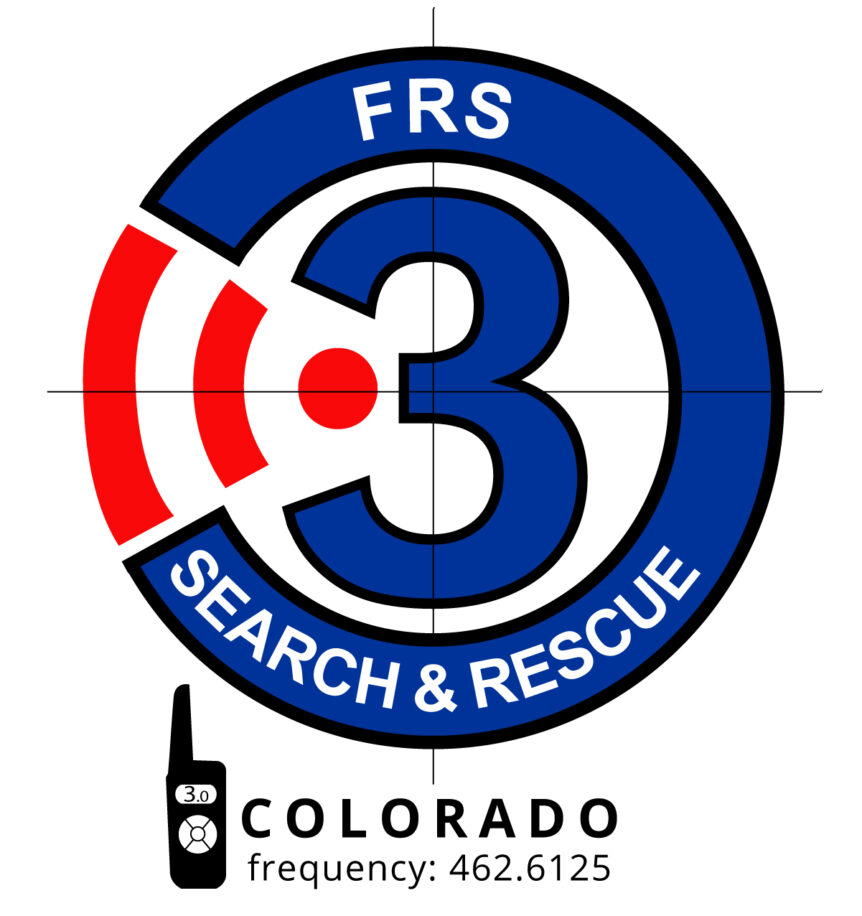By Bruce Beckmann, Colorado Search and Rescue Association state coordinator and Alpine Rescue Team member
EXECUTIVE SUMMARY
If someone becomes lost or injured in the Colorado backcountry and is using family radio services or general mobile radio service radios (both types referred to herein as “FRS” radios), Colorado Search and Rescue Association (CSAR) designates FRS radio Channel 3.0 [462.61250 MHz] as the default during backcountry search and rescue (backcountry SAR) emergencies. If other methods of communication are not being used, backcountry SAR responders, if equipped, may default to Channel 3.0 to communicate with those involved. If possible, others are encouraged to monitor Channel 3.0 but not to use it for routine communications, so that in the event someone calls for assistance they can help get word to the
local 911 dispatch center or assist directly. Backcountry SAR teams in Colorado do not actively monitor FRS/GMRS channels but most will be able to utilize FRS radios once they have been alerted by a 911 dispatch center and have arrived in the area of the incident.

DISCUSSION
Once you have left the trailhead, you’ve entered the Colorado backcountry and need to be prepared to manage dangers. As Reinhold Messner said, “Mountains are not fair or unfair, they are just dangerous.” In today’s technology-driven society, we have access to many communication devices such as cellphones, personal locator beacons, two-way satellite messengers, satellite phones, and handheld radios such as FRS radios and amateur radios (ham). Cell phone reception cannot be relied upon in the Colorado backcountry. This position paper specifically addresses FRS radio usage during backcountry emergencies in Colorado. To read more about handling backcountry emergencies in general, please visit CSAR’s blog.
FRS radios are small, handheld radios used by many backcountry enthusiasts to communicate with friends or other outdoor adventurers nearby. Backcountry Access and Rocky Talkie are two Colorado-based manufacturers of FRS radios. These radios are generally used for a short range, up to a few miles, depending on the terrain and elevation. An FCC license is not required to use the FRS radio. Please note, FRS and GMRS share channels 1-7.
FRS radios have at least 22 primary channels and 38 or more “sub-channels”(Note 1) that can be mixed to create an array of combinations, giving users many channel options. Often groups use a specific channel and sub-channel so as not to be bothered by others. However, during an emergency, using a simple and easy to remember channel and no sub-channel, or sub-channel of 0 (zero), is the best option. In Colorado, this is channel 3 (462.6125 MHz) with no sub-channel (Channel 3.0).
In the event of a backcountry emergency:
■ If the subject or party member has an FRS radio, they may describe the nature of the emergency and ask for help from anyone else listening; other recreationists in the area may be able to call 911 or respond to the subject’s aid themselves.
■ Once responders are notified and en route, unless the local sheriff’s office or Backcountry SAR team advises otherwise, CSAR recommends all parties switch to Channel 3.0. Responders may try to contact subjects on this channel, although be aware not all Backcountry SAR teams have FRS radios nor do they monitor Channel 3.0.
■ Responders to a backcountry emergency may ask folks using Channel 3.0, but not involved with this incident, to kindly move to another channel.

CSAR’s Choice of Channel 3.0
CSAR is designating Channel 3.0 as the default FRS option for Colorado backcountry emergencies and requesting that all users respect this designation. While CSAR has no authority over this channel, we ask FRS users to respect that emergency radio traffic should take priority.
Why Channel 3.0? Three is consistent with the universally-recognized distress signal of three whistle blasts or three gunshots, or the three letters of SOS. Channel 3.0 is universally usable across all manufacturers of FRS radios. Without the sub channel, rescuers can hear anyone on this channel, but if the field party is using channel 3 with a sub-channel, they will not hear SAR calling them. Please note, Wyoming has the “Be 307 Aware” program, designated after the Wyoming area code. CSAR is going with the simpler Channel 3.0. (Note 2) From our experience, some users of FRS radios may not invest the time to understand the intricacies of their radio. On some radios, setting up Channel 3.0 can be done in advance and users can then be taught simply to go to Channel 3.0 during an emergency.
Please note that various user groups in Colorado have also designated community or “zone” FRS radio channels in certain popular outdoor recreation areas. You can learn more about these channels on Rocky Talkie’s website here.
CONCLUSION
Having direct communications with rescue subjects can be crucial during emergencies. Although SAR teams do not actively monitor any FRS channel, establishing a common go-to channel when SAR has been activated by other means and are en route can greatly aid rescue operations and ultimately help save lives. CSAR is designating Channel 3.0 as the default FRS option during Backcountry SAR emergencies.
Notes:
1 The FCC identifies the privacy codes as “Privacy Tones.” They are also referenced in various readings as PL tones, sub-channels, CTCSS Tones, or DCS tones. For this discussion, we will use the term “sub-channel.”
2 There are many manufacturers of FRS/GMRS radios, some with more channels than 22. Some radios have channels pre-programmed with preset sub-channels. Regardless, these radios still have the first 22 channels without a sub-channel, as the main FCC/FRS channels. The only channels that are consistent amongst all radios are the first 22.
Many thanks to Margaret Deluca of Alpine Rescue Team for donating her graphic design services to produce the Colorado FRS channel 3.0 logo.

